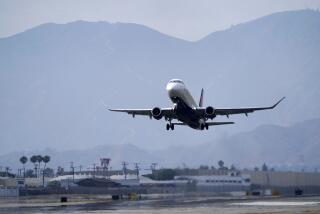Gamble in the Air
- Share via
The Federal Aviation Administration’s decision to cut in half the standard separation between aircraft operating at high altitudes is dangerously irresponsible. Airline passengers grumble about the increasing frequency of delayed departures from busy airports. But, as spokesmen for airline pilots and FAA controllers correctly observe, increasing the burden on an already overloaded air-traffic-control system is not an acceptable way to get them off the ground.
Under the change announced last week, controllers will reduce the normal horizontal distance between aircraft cruising at high altitudes from 20 miles to 10 miles. The reduction in standard separation will not affect the legal minimums, which will remain at five miles horizontal separation and either 1,000 feet or 2,000 feet vertical, depending on how high a plane is flying.
High-altitude routes are flown by airliners, military aircraft and many corporate planes.
The major pressure for the change came from the airlines, which are unhappy about the high incidence of delayed takeoffs--especially at “hub” airports such as Atlanta, Chicago and Denver, which serve as transfer points for flights originating and terminating elsewhere.
To a major extent, however, the delays are generated by the competing airlines themselves, which under deregulation have, more than ever, bunched arrivals and departures in the early-morning and late-afternoon rush hours. The first priority should go to achieving cooperative arrangements shifting more flights to non-peak periods. Fortunately, the government is trying to push the airlines in that direction.
The main danger in reducing separation standards is not that a 10-mile separation will cause planes cruising at high altitudes to run into each other. The real problem will be the increased number of planes that must be handled by controllers in the airport approach and departure stages.
If safe separation of ascending and descending planes is to be maintained, more airliners will have to be put into holding patterns; this will increase the workload on controllers, who will then have less time to detect and deal with potential collision situations between airliners and other planes that may stray into their path.
Recent tragedies, including the collision over Cerritos, have dramatized that the system is over-burdened as it is. Apart from more sensible airline scheduling, the answer lies in more controllers and in accelerated acquisition of new radars and computers.
By dumping more traffic onto the existing system before these improvements are made, the FAA is gambling with the safety of the traveling public. If a tragic accident occurs as a result of the decision, the responsibility will lie squarely at the door of FAA Administrator Donald D. Engen.
More to Read
Inside the business of entertainment
The Wide Shot brings you news, analysis and insights on everything from streaming wars to production — and what it all means for the future.
You may occasionally receive promotional content from the Los Angeles Times.










